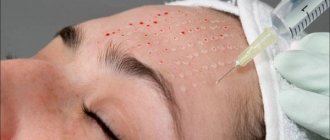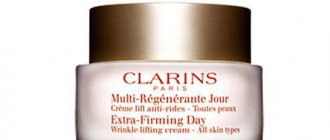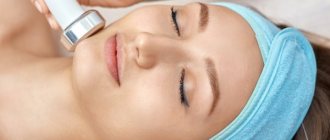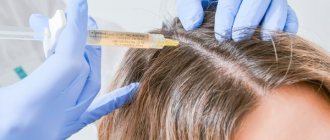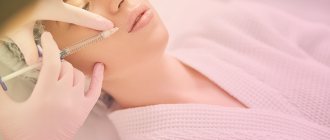A modern woman can maintain her youth without resorting to surgery. For this, the beauty industry offers different solutions. One of them is bioreparation - introducing a mixture of useful substances into the subcutaneous layer using injections. Each such youth cocktail is aimed at rejuvenating the skin, launching the natural production of elastin and collagen, as well as saturating the epidermis with an important substance - hyaluronic acid. What it is, what drugs are used during the procedure, and what you need to know before agreeing to injections will be discussed further.
Indications for use
Bioreparation is recommended for women over 35 years of age if they have the following problems:
- wrinkles;
- excessive dry skin;
- acne;
- stretch marks;
- loss of tone and ptosis;
- scars;
- excessive pigmentation;
- rosacea
The procedure is also prescribed for skin rehabilitation after other rejuvenation techniques that have an aggressive effect.
Efficiency
Bioreparation can be carried out on different parts of the body. It is most often used to correct problem areas of the face. After the procedure, the following biochemical processes occur:
- Collagen and elastin are actively produced;
- fats are broken down;
- local immunity increases;
- skin regeneration starts;
- the deficiency of hyaluronic acid is replenished.
Outwardly it appears like this:
- skin tone increases;
- Scars and acne become less noticeable;
- pigmentation decreases;
- improves complexion;
- an oval is formed;
- the skin is saturated with moisture and noticeably tightened.
Attention! The procedure reduces and slows down the signs of aging. But you shouldn’t count on complete facial rejuvenation, like in your youth. It will not correct irreversible age-related phenomena.
Review of manufacturers
Preparations for bioreparation (bioreparants) are a mix of vitamins, peptides, amino acids and other useful components based on modified hyaluronic acid. In this form, they get under the skin and linger in the injection sites for a long time - 3-4 weeks. This allows you to use the drugs to the maximum, launching the body’s own rejuvenation processes. Depending on the condition of the patient’s skin, the doctor offers different bioremedies for the procedure.
Meso-Xanthine F199 (USA)
Mesoxanthin F199 (Meso−Xanthin) protects DNA cells and preserves youthful skin. Recommended for bioreparation for persons over 28 years of age. For older women (40 years or more), it is better to use it in combination with another drug - Meso-Warton.
Main components:
- high molecular weight hyaluronic acid;
- vitamins;
- amino acids;
- growth factors;
- The key component obtained from seaweed is the carotenoid Fucoxanthin, which “corrects” disturbances in the functioning of cells. As a result, the new cell carries the message of being young and healthy, the skin looks tightened, the complexion improves, and the aging process slows down.
The bioreparant Mesoxanthin is recommended for use in a course of up to 4 sessions every 7–10 days.
Another drug from the same series, Meso-Wharton P199, has a similar effect. Its difference from Mesoxanthine is that it contains peptides that increase the number of its own stem cells. As a result, the dermis is rejuvenated for several years. The procedure that uses peptides is also known as peptide bioreparation. Recommended for women over 40 years old.
Plenhyage (Italy)
The composition of the bioreparant Plenage includes polynucleotides that actively restore and rejuvenate the skin layers. The product has antioxidant, leveling and protective properties. You don't have to wait long for results. The effect is visible immediately after the procedure. For many cosmetologists, it is included in the unspoken top “best bioremedies”.
Important! An allergic reaction is possible in people with seafood intolerance.
Gialripayer (Russia)
It is a line of several bioremedies.
Hyalrepair 02
The drug Hyalripayer 02 eliminates sagging, wrinkles, scars, and stretch marks of the skin. The tone increases.
Compound:
- hyaluronic acid modified with vitamin C;
- lysine;
- proline;
- glycine.
Prescribed in a course of 3–4 procedures every 14–21 days.
Hyalrepair 04
Increases hydration, tone, elasticity of the dermis. Improves complexion, eliminates age spots. Smoothes out fine wrinkles and eliminates environmental consequences, including acne, acne, rosacea. Can be used from the age of 25. It is recommended to complete a course of 3–5 procedures with an interval of 2–3 weeks.
Main components:
- hyaluronic acid;
- ascorbic acid;
- cysteine.
Hyalrepair 08
In addition to hyaluronic acid and vitamin C, the composition contains L-carnitine. It is a unique bioreparant that can not only create a lifting effect and healthy skin, but also reduce the size of the fat layer on the neck, décolleté, and arms.
It is carried out in a course of 3–5 procedures every 21 days.
KHARIZMA (France)
There are several types of bioremedies in the Charisma brand line.
Bio Revitalift
The effect is noticeable from the first use. When completing a full course, the results last a long time. The timing depends on individual circumstances.
Contains:
- hyaluronic acid;
- peptides;
- vitamins;
- amino acids;
- sodium chloride solution.
There are 2 options for taking the course:
- standard - 3-4 sessions every 21-28 days, then another 2-3 sessions to maintain the result throughout the year;
- intensive - 6 procedures at intervals of every 2 weeks, after - another 5 or 6 sessions throughout the year.
KHARIZMA Ultra
Components of the drug:
- hyaluronic acid (8 mg/ml);
- amino acids;
- coenzymes and minerals;
- vitamins;
- sodium chloride solution.
Like the previous drug, it can be carried out in two courses. The program for undergoing them is drawn up in each individual case, depending on the condition of the patient’s skin.
KHARIZMA Light
The composition contains the same components as the Ultra bioreparant. Hyaluronic acid is present here at a concentration of 6 mg/ml. Also used as a standard or intensive course.
KHARIZMA Forte
It has characteristics similar to previous versions. The concentration of hyaluronic acid in the preparation is 7 mg/ml.
VIVIFY (Korea)
Vivifay Rejuvenating Soft Filler is a peptide biorepair for people aged 46–65 years. Contains:
- 24 amino acids;
- 3 biomimetic peptides;
- 14 vitamins;
- hyaluronic acid;
- 8 coenzymes and minerals.
Promotes cell activation, natural skin renewal, and own collagen synthesis. Instantly moisturizes the epidermis and protects the skin from free radicals and ultraviolet radiation.
Dermaren lumi (Korea)
Dermaren lumi 10.0 (Dermaren lumia) is a filler with polydeoxyribonucleotides (PDRN) and hyaluronic acid. Restores the original shape of the face, affecting DNA at the intercellular level. Smoothes wrinkles, evens out and moisturizes the skin, tones it.
Mixyal Density (Switzerland)
Recommended for working with mature smoker’s skin, as well as “tired” skin, fine-wrinkled aging, post-acne, and disorders of the epidermal barrier. Contains:
- hyaluronic and aspartic acid;
- minerals;
- DNA nucleotide;
- vitamins;
- amino acids.
REVITA (France)
Bioreparant Revita Derm is recommended for rejuvenating tired and aging skin, as well as when it comes to recovery after surgery and peeling. The composition contains: hyaluronic acid, amino acids, sodium sulfate.
What is biorevitalization
Biorevitalization is a current cosmetic procedure that involves intradermal injection of chemically unchanged hyaluronic acid.
Hyaluronic acid attracts water molecules and stimulates the work of fibroblast cells, which, in turn, synthesize collagen and elastin fibers.
The effect is noticeable within 1-2 days. However, it only lasts for 2-4 weeks.
Unfortunately, an extremely small number of doctors focus on the fact that hyaluronic acid preparations are foreign substances to the body, and their administration can serve as a trigger for the development of autoimmune and oncological diseases.
The cost of biorevitalization is 6,000 rubles
Advantages and disadvantages
| Advantages | Flaws |
|
|
Buyanov Sergey Yurievich (Expert Doctor):
Biorevitalization literally means: “restoration of the living.” That is, in relation to the skin, this is the resuscitation of dying cells. Epithelial cells “die” every month, replaced by new ones. Revitalization delays the process of early maturation, therefore, keeps the skin from age-related changes.
How does the procedure work?
Before starting the injection, the specialist opens the box in front of the patient, demonstrates the contents of the drug, draws attention to the expiration date and manufacturer. If the bioreparant is produced in bottles, it often comes with two sterile needles for changing during use when one of them becomes dull.
It is important that the drug is of high quality, sterile and not expired. The experience of the doctor also plays a role in obtaining the result. This must be a highly qualified specialist with a good reputation, who is well versed in the nuances of a particular drug, knows how to choose the right remedy for any patient and can provide assistance if necessary.
If these nuances are met, then the bioreparation procedure itself follows.
- Anesthesia. A layer of gel or analgesic ointment is applied to the skin and the time is waited until the painkiller begins to take effect - about 30 minutes. If all rules are followed, the patient will not feel pain. In some cases, itching or slight tingling may be observed, similar to the sensations after taking a test for the reaction of any drug.
- Asepsis. The area where bioreparation will be carried out is wiped with a special antiseptic. Most often, a 0.5% chlorhexidine solution is used for these purposes.
- Administration of injections. Using the papular technique, the selected drug is injected under the skin with a syringe in a dose that the doctor calculates depending on what problems with the dermis need to be solved during the session. Punctures are made at a distance of approximately 1 cm. In the décolleté area - 2 cm. At this stage, the doctor controls the diameter of the resulting papule - 3 mm each on the face and neck, no more than 1 mm in the eyelid area.
- Asepsis again.
- Application of a special product that soothes the skin and enhances the effect of the biorepair.
Note! Anesthesia is not always used during the procedure. If the patient wishes, this item can be skipped. It is believed that in this case there will be a lower likelihood of hematomas. But it is worth considering that the procedure is quite painful, and it is better for people with a low pain threshold to use analgesics.
The session lasts 45–60 minutes, including the time when the anesthesia begins to take effect.
Upon completion, the patient is given a card with the name of the drug and its number.
Features of bioreparation
Bioreparation refers to invasive methods of autonomous action on the skin, involving the introduction of a special drug, the main component of which is hyaluronic acid, which provokes the production of its own collagen. The main task of the procedure is to provide natural protection and activate the body’s own reserves.
Bioreparation is indicated for:
- aging of the skin, accompanied by facial wrinkles and loss of turgor;
- formation of scars and keloids;
- drooping upper eyelid;
- the first signs of photoaging and the appearance of age spots;
- uneven and blurred facial contour;
- dull color of the dermis;
- acne;
- stretch marks and stretch marks;
- excessive dry skin.
Due to the whole symbiosis of the components that make up the drug, increased immunity, improved hydration and the elimination of fine expression wrinkles are achieved. The procedure can be performed autonomously - injections are made into problem areas. Very often they resort to it as a preventive measure in terms of preventing aging, when a woman, having passed the 30-year mark, began to notice the first signs of skin aging on her face.
Important point: The effect of introducing bioremedies is cumulative. The technique is carried out in courses - 3-6 sessions with a three-week interval (the number of sessions is prescribed by a cosmetologist, taking into account age and existing problems).
You will notice the first results after 1.5–2 weeks, when collagen production occurs and the skin is nourished with useful substances.
The procedure is virtually painless due to the use of anesthetics. Sometimes no anesthesia is required when the esthetician uses very fine needles to inject fluid.
As a rule, the cleansed face is treated three times with an anesthetic and chlorhexidine solution in order to disinfect the areas.
The cosmetologist makes punctures, introducing a reparative based on hyaluronic acid, amino acids and vitamins under the skin. Maintain a distance between punctures: for the face - 1 cm, for the neck - 1.5 cm, and for the décolleté - 2 cm. The depth of the punctures themselves is 1-2 mm, but in the eye area, where the skin is very thin, a maximum of 1 mm .
Rehabilitation period
If a high-quality drug is selected and the procedure is performed by an experienced doctor, then the rehabilitation period does not last long - 2-7 days.
What you can expect after injections:
- formation of papules that resolve differently depending on the drug;
- bruises;
- swelling, redness;
- mild pain.
As a rule, swelling and pain disappear within the first day. Papules may be visible for 2–3 days.
In the first week it is advisable to give up:
- visits to saunas, swimming pools, solariums;
- tanning;
- drinking alcohol;
- going outside without sunscreen.
It is very important to prevent increased blood circulation in the treated areas. Therefore, it is not recommended to do massages, peelings and other procedures. For the same reason, it is worth limiting physical activity.
While puncture wounds are healing, you should treat them with an antiseptic and avoid touching your face with your hands. In the first days, you should not use decorative cosmetics to avoid infection.
If hematomas form, the doctor may recommend a special ointment.
On average, the duration of the effect is 6–12 months. Then the procedure must be repeated in a course of several sessions, the number of which is determined by the cosmetologist.
Recommendations for post-procedure care
Immediately after the procedure, the patient can return to his normal life. However, it is worth considering that after bioreparation, papules (small balls) form on the treated area of skin, and swelling, induration and bruising are also possible. Therefore, it is better to schedule a session so that you have the opportunity to not leave the house for 2-3 days until your face returns to normal. In addition, it is necessary to follow a number of rules after carrying out this cosmetic manipulation:
- The puncture sites should be periodically treated with an antiseptic to prevent the development of infection.
- To avoid the formation of large hematomas, immediately after the bioreparation procedure, ice must be applied to the puncture sites. Cold compresses can be continued for another 2-3 days.
- For the first few days, it is important to prevent overheating of the epithelial tissue (do not visit the sauna, bathhouse, etc.).
- You should not drink alcohol for at least a week after bioreparation. Firstly, it thins the blood, which increases swelling and bruising, and secondly, it promotes faster breakdown of the active components of the drug, which reduces the effectiveness of the cosmetic procedure.
- You should not massage your face, as it also increases blood circulation and reduces the effectiveness of hyaluronic acid. It is best to exclude any mechanical impact on the skin during the entire course of bioreparation procedures.
- Patients prone to the formation of age spots should use sunscreen regardless of weather conditions.
How much does it cost and where is it made?
In special clinics. The procedure is carried out by specialists with appropriate education. You should not go to standard beauty salons and carry out the procedure at home. The session requires special preparation, sterile conditions and qualified assistance in case of adverse reactions to the drug.
Depending on the qualifications and demand of the doctor, as well as the prestige of the chosen clinic, prices per session range from 9,000–25,000 rubles.
The average price in different cities of Russia is presented in the table:
| City | Approximate cost for one procedure in rubles |
| Moscow | 8 000 – 9 000 |
| Saint Petersburg | 7 500 – 8 000 |
| Nizhny Novgorod | 6 500 – 7 500 |
| Almaty | 6 000 – 7 000 |
| Krasnodar | 6 500 – 7 000 |
| Tomsk | 6 000 – 7 000 |
| Kazan | 6 500 – 7 500 |
| Novosibirsk | 6 000 – 7 500 |
| Chelyabinsk | 6 000 – 7 000 |
| Orenburg | 6 500 – 7 000 |
Why you shouldn't drink alcohol
There is no direct evidence that alcohol is harmful after bioreparation. As well as a clearly indicated time frame, exactly how long after the procedure it cannot be used. But it has been proven that alcohol:
- dilates blood vessels;
- destroys vitamins that preserve collagen - C, E;
- dries out the skin;
- provokes the formation of edema;
- prevents the retention of hyaluronic acid in tissues.
All these factors can negatively affect the bioreparation performed, reduce the effect and shorten its duration. Therefore, during the first days of rehabilitation, doctors strongly recommend abstaining from alcohol.
Contraindications
Despite the fact that modern cosmetology strives to make rejuvenation procedures as safe as possible, you should not resort to bioreparation if:
- intolerance to components in the drug;
- diabetes mellitus;
- epilepsy;
- skin infections of various origins;
- blood clotting disorders;
- viral and bacterial diseases;
- pregnancy and lactation;
- malignant and benign tumors.
Important point! You should not carry out the procedure during menstruation to avoid excessive formation of hematomas.
When the technique is contraindicated
Many women are wary of much-touted injections and punctures. The most frequently asked question to cosmetologists is: “Bioreparation is as effective as they say it is, or is it a planned marketing ploy?” Of course, the described technique will not turn an adult woman into a twenty-year-old girl. But it will significantly hide the visual symptoms of age-related deformations and stop their development.
There are several contraindications to bioreparation:
- Allergic rash to vitamin C;
- The skin at the injection site is significantly damaged;
- Diseases associated with impaired functioning of the immune system;
- Tumors are benign or malignant;
- Herpes in the form of rashes;
- Blood flow disorders;
- Insufficiency of the pancreatic hormone insulin.
After completing the course of procedures, a lifting effect in the affected area, an increase in skin elasticity and color will be noticeable. It becomes as smooth as possible, is well and long-lastingly saturated with nutrients, acne and scars after poor cleaning are reduced.
Consequences
After bioreparation, there may be slight swelling, bruising, mild soreness and noticeable papules. As a rule, this all goes away within a few days. But if the swelling increases, the pain intensifies - this can become a signal of inflammation.
Such phenomena can be caused by the inexperience of the doctor, violation of sterility during the procedure, and infection through unhealed injection wounds.
Violation of injection technology is fraught with other consequences:
- formation of scars at puncture sites;
- fibrous formations under the skin;
- partial blockage and compression of blood vessels;
- tissue necrosis.
In rare cases, an allergic reaction to the components of the drug may occur: itching, burning, redness, anaphylactic shock. Then antihistamines are used. To avoid allergies, it is recommended to undergo an allergic reaction test before starting bioreparation.
If there are any warning signs, it is important to consult a doctor immediately.
Advantages and disadvantages of bioreparation
Advantages of the bioreparation procedure:
- complete absence of pain;
- proven effectiveness;
- long-lasting anti-aging effect;
- a wide range of indications for the procedure;
- lack of regeneration period;
- Photos after the first session prove the immediate aesthetic result.
Disadvantages of the bioreparation procedure:
- high price;
- the multicomponent composition of the product can cause rejection reactions in the body;
- high probability of allergic reactions.
Why there is no effect
It happens that the procedure is done, but there is no effect. The reason for this may be the individual characteristics of the skin. And in subsequent sessions the result will definitely be noticeable. That is why bioreparation must be completed in a full course.
There are also cases when a low-quality drug that has not been certified is administered during the procedure. Therefore, it does not give the desired effect, or even harms it. To avoid this, you need to contact a specialized clinic, a doctor of the highest category, and be sure to ask for a quality certificate for the drug that will be injected under the skin.
What is better to choose
The visual effect of both procedures is almost identical, so the choice of technique largely depends on the professional opinion of the doctor you consult.
A competent specialist will certainly conduct a qualitative assessment of the condition of your skin, take into account its individual characteristics and offer the optimal method to solve the problem.
Remember that the most persistent and long-lasting effect of bioreparation is considered a significant difference. But biorevitalization can be carried out from an early age - in this case, this procedure can slow down the aging process of the skin.
Difference from other procedures
Bioreparation is often confused with other anti-aging procedures.
Invasive biorevitalization
In both cases, the drug is injected under the skin. The difference between the procedures is that biorevitalization involves the introduction of hyaluronic acid without impurities; it stays in the subcutaneous layers for no more than three days, so the effect of the procedure is less long-lasting.
It is biorevitalization that is recommended for women who have not yet resorted to injection rejuvenation.
As for bioreparation, during the session cocktails of hyaluronic acid and other beneficial substances are used, which not only enhance the rejuvenation effect, but also retain hyaluronic acid in the tissues for about three weeks.
This period is enough to launch the natural processes of collagen, elastin production and cell regeneration. This procedure has a longer effect. And it is recommended for mature age.
Mesotherapy
With mesotherapy, the drug is also administered by injection. Hyaluronic acid is used in lower concentrations. You need to complete more sessions per course - at least six. The procedure is recommended for young women who are susceptible to signs of early aging. Also, in the case of mesotherapy, it is possible to mix individual drugs to create an individual rejuvenating cocktail. During bioreparation, only ready-made bioreparations are used, and the procedure itself is recommended for women over 35 years of age.
Fillers, contouring
The action of fillers is aimed at introducing hyaluronic acid into the desired areas to give them volume, form the facial frame, and smooth out fine wrinkles. Contour plastic surgery is designed to create a cosmetic effect that must be constantly maintained, since the hyaluronic acid is absorbed after 6–12 months. Bioreparation has a healing effect and triggers its own rejuvenation processes, which is why the effect is longer lasting.
Comparison with other methods
Bioreparation is more effective compared to other procedures. It launches the natural process of cell regeneration. The effect lasts up to a year.
The technique of administering the drug is similar to biorevitalization. The difference is in its composition and action.
- During bioreparation, a cocktail of components is used, which triggers natural rejuvenation processes. It is recommended for people over 40 years of age.
- The action of biorevitalizants is aimed at replenishing moisture and smoothing wrinkles. It can be done for 25 years.
The main differences from the injection of fillers or Botox are that they act locally and are used mainly to add volume to the lips or cheekbones.
Mesotherapy differs in indications for use and age limit. Mesococktails are made to nourish and strengthen the skin, reduce pores and scars. They are allowed from 18 years of age.
Opinion of cosmetologists
Reviews on specialized forums help to find answers to questions that arise in the work of a cosmetologist every day.
In this review, the specialist tells you what is better to choose depending on the condition of the skin: biorevitalization or bioreparation.
She shares details about the procedure itself here https://vk.com/topic-17757400_34820346.
Cosmetologists also discuss the drugs themselves and what the reaction to them may be. They mention that most often the body reacts to peptides:
But there are experts who draw attention to the fact that it is impossible to say unequivocally which drug is better. And here it all depends on who is used to working with what. The main thing is to choose the right doctor for the procedure.
Patient reviews
Patients tell different things about bioreparation.
Some are simply delighted with this procedure and say that there is an effect after several sessions.
This review talks about how important it is to write down all information about the procedure in special books:
The following explains what exactly should be written in them:
There are cases when patients note a lack of results after the first session. Although in this review the patient was satisfied with the moisturizing effect of the procedure and recommends testing bioreparation on yourself:
You can read more about the reviews here https://otzovik.com/reviews/kosmeticheskaya_procedura_bioreparaciya/.
And, of course, people are not always satisfied after bioreparation. As, for example, in this case.
Bioreparation helps improve skin condition. This is evidenced by numerous reviews from those who have experienced its effects on themselves. But in order to get the desired effect, you should carefully prepare for the procedure, complete the full course and follow the doctor’s recommendations during the rehabilitation period.
But the most important thing is the choice of a specialist. It is his qualifications that will protect you from sad consequences after an incorrectly performed procedure. After all, injections are a serious test. And only an experienced cosmetologist can guarantee the result and not only rejuvenate the skin, but also save the patient’s invaluable health from unnecessary shocks.

